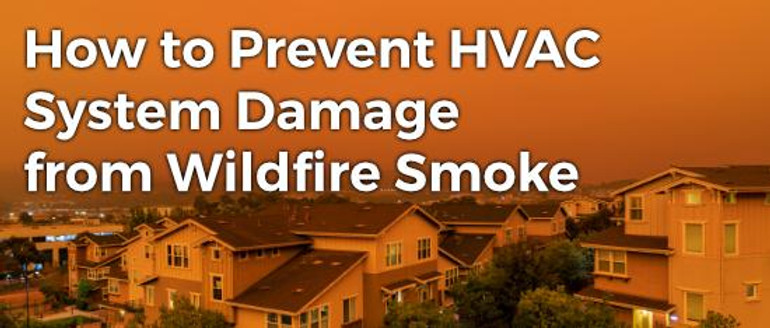As wildfires become increasingly prevalent, understanding the profound impact of smoke on residential HVAC (Heating, Ventilation, and Air Conditioning) systems is crucial. Smoke from wildfires carries a myriad of harmful pollutants and particles that can infiltrate homes and compromise the functionality and efficiency of HVAC systems. In this highly technical and detailed article, we will explore the effects of wildfire smoke on HVAC systems, as well as provide comprehensive guidance on mitigating damage and restoring optimal performance once the smoke has cleared.
The Composition of Wildfire Smoke
Wildfire smoke is a complex mixture of gases, fine particles, and volatile organic compounds (VOCs) that can have a profound impact on residential HVAC systems. Understanding the composition of smoke is crucial in comprehending its effects and implementing appropriate measures to mitigate damage.
Particulate Matter
Wildfire smoke contains a wide range of particulate matter, classified based on size as PM10 (particles with a diameter of 10 micrometers or less) and PM2.5 (particles with a diameter of 2.5 micrometers or less). These fine particles can easily infiltrate indoor spaces through gaps, windows, and ventilation systems. Due to their small size, they can linger in the air for an extended period, leading to prolonged exposure.
Carbon Monoxide (CO) and Nitrogen Oxides (NOx)
The combustion process during wildfires releases carbon monoxide and nitrogen oxides into the air. Carbon monoxide is a colorless and odorless gas that can be harmful when inhaled in high concentrations. Nitrogen oxides contribute to the formation of ground-level ozone and can cause respiratory issues.
Volatile Organic Compounds (VOCs)
VOCs are organic chemicals that vaporize at room temperature. They are released during the burning of vegetation and can include substances like formaldehyde, benzene, and acrolein. VOCs contribute to poor indoor air quality and can have both short-term and long-term health effects.
Hazardous Air Pollutants (HAPs)
Wildfire smoke also contains hazardous air pollutants such as polycyclic aromatic hydrocarbons (PAHs), which are byproducts of incomplete combustion. PAHs have been associated with various health risks, including respiratory issues and potential carcinogenic effects.
Sensitivity to Smoke Composition
Different regions may experience variations in the composition of wildfire smoke, depending on the vegetation types burning, atmospheric conditions, and distance from the fire source. This variability can influence the severity of smoke infiltration and the specific pollutants present, emphasizing the need for localized awareness and tailored mitigation efforts.
Recognizing the diverse components within wildfire smoke, you will understand the challenges faced by their HVAC systems and make informed decisions when it comes to preventative measures, filtration systems, and post-smoke restoration procedures.
Impact of Wildfire Smoke on HVAC Systems
Wildfire smoke poses significant challenges to residential HVAC systems, which are designed to circulate and condition indoor air. The infiltration of smoke particles and pollutants can lead to various operational and maintenance issues. Understanding the potential impacts is crucial for homeowners to address the effects promptly and restore their HVAC systems to optimal functioning.
Filter Contamination
One of the primary concerns during wildfire smoke exposure is the contamination of HVAC filters. Smoke particles, including PM2.5 and PM10, can quickly clog filters, reducing their efficiency and impeding airflow. As a result, the HVAC system may struggle to maintain proper ventilation and air circulation throughout the home.
Reduced Indoor Air Quality
The infiltration of smoke can significantly degrade indoor air quality. The presence of fine particles, volatile organic compounds, and hazardous air pollutants can cause respiratory discomfort, exacerbate allergies, and contribute to overall health issues. Individuals with pre-existing respiratory conditions, such as asthma or chronic obstructive pulmonary disease (COPD), may be particularly vulnerable to the effects of smoke.
Damaged Components
Wildfire smoke contains corrosive compounds and soot that can harm HVAC system components. Smoke residue can accumulate on fan blades, motors, electrical connections, and other sensitive parts, leading to reduced efficiency, increased wear and tear, and potential malfunctions. Ignoring the cleaning and maintenance needs post-smoke exposure can result in long-term damage to the system.
Ductwork Contamination
Smoke particles can infiltrate the ductwork, spreading throughout the home and potentially accumulating on the inner surfaces. This contamination can persist even after the smoke has cleared, continuously reintroducing pollutants into the indoor environment when the HVAC system is operating.
Odor and Lingering Effects
Wildfire smoke can leave behind persistent odors in the home, which may require specific remediation steps to eliminate. Lingering smoke particles and pollutants can continue to affect indoor air quality, causing discomfort and health concerns even after the visible signs of smoke have dissipated.
The impact of wildfire smoke on HVAC systems underscores the importance of taking proactive measures to safeguard the system's performance and maintain healthy indoor environments. Proper filtration, regular maintenance, and prompt post-smoke restoration efforts are essential to mitigate the short-term and long-term effects of smoke infiltration in HVAC systems.
Steps to Protect HVAC Systems during Smoke Exposure
Filter Inspection and Replacement
Regularly inspect and replace HVAC filters during and after wildfire smoke events. If filters appear discolored or clogged, replace them promptly.
While it may be tempting to use a higher MERV-rated filter to capture more pollutants, you risk limiting airflow over the evaporator coil, and may cause it to ice up, and prevent the A/C from effectively cooling the home. What we recommend instead is to inspect the filter and change more often during these times.
Limit Outdoor Air Intake
Adjust the HVAC system to minimize outdoor air intake during a wildfire event. Locate the dampers or controls that regulate outside air and reduce the amount being brought into the system. Additionally, keep windows and doors closed to prevent smoke infiltration.
Seal Ductwork Openings
Inspect the ductwork for visible gaps, cracks, or openings that may allow smoke to enter. Use appropriate HVAC tape or mastic sealant to seal these openings and prevent smoke from spreading through the ducts.
Prevent System Contamination
During heavy smoke periods, hose off the outside condenser coil and inspect the fan blades for smoke contamination. Clean smoke off the blades if necessary.
Post-Smoke Measures and Restoration
System Inspection
Once the smoke has cleared, conduct a thorough inspection of the HVAC system. Check for any smoke-related damage, clean affected components, and identify any potential issues that require repair or replacement. If necessary, clean the ductwork to remove smoke residue and improve indoor air quality.
Filter Replacement
We emphasize the importance of promptly replacing air filters post-smoke exposure to prevent recirculation of trapped smoke particles.
Indoor Air Purification
Utilize air purifiers equipped with high-efficiency particulate air (HEPA) filters to enhance indoor air quality and eliminate residual smoke particles. These purifiers effectively capture smoke-related pollutants and help eliminate lingering odors. Explore additional options such as activated carbon filters or UV germicidal irradiation to address specific concerns.
Duct Cleaning and Inspection
If the ducts are dirty, and odor lingers after the smoke has cleared, a duct cleaning may be in order. While we often empower homeowners to perform their own repairs, a professional cleaning of ductwork are crucial to remove smoke residue and remediate any remaining smoke odor.
By implementing preventive measures, conducting post-smoke assessments, and taking appropriate restoration steps, homeowners can safeguard their HVAC systems and maintain healthy indoor environments. Prioritizing professional expertise and adopting effective strategies will help ensure the longevity and optimal performance of HVAC systems in the face of increasing wildfire events.
About the Author

James Clark is the Ecommerce Manager of TechnicalHotandColdParts.com and HVAC Controls Specialist (certified in Tridium and Carrier i-Vu controls) with a decade of experience at Technical Hot & Cold. His extensive background includes service calls, installations, and providing technical support to parts customers. James has been featured in the Washington Post and continues to share his knowledge, helping homeowners navigate HVAC repairs. In his spare time, he's playing music with his children and spending too much time working on his lawn.

